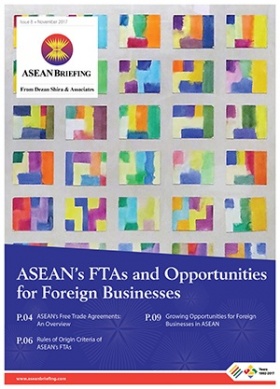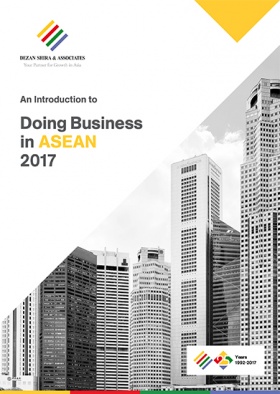AEC in Practice – What Can Foreign Investors Do Now?
Much like the European Union, the ASEAN Economic Community (AEC) is founded on several unchanging pillars. The community is supposed to create a single market and production base, support one another in increasing competitiveness, close gaps of an economic nature and other disparities, and to further integrate with the global economy.
In a previous article , we laid out the relationship between ASEAN’s largest markets and Germany, and we will now explain what investors can do to act on this potential. In a survey conducted by Germany Trade and Invest, German firms operating within ASEAN indicate that they are excited by new opportunities presented by the AEC and are ready to seize them. However, unlike their invested counterparts, companies not yet operating in the region continue to register reservations about committing capital. This hesitance has led German firms to fall behind other competitors, such as Japan, who have been successfully leveraging tariff removals and other benfits of found within the region.
To understand the AEC, it is paramount to be aware of its geopolitical background as well its fundamental differences to the European Union. Once it is clear that, although on paper the AEC looks like the European Union, it remains a long way from the EU’s level of integration, it becomes clear what investors can do to operate successfully.
The European Union and the AEC Compared
Similarities
Both the EU and AEC have similar intentions in building a strong regional body based on cooperation. Most member countries in both regions are geographically small, but together they can withstand threats posed by larger countries. ASEAN’s relationship with China is paradoxical in this sense. On the one hand, many countries hope for, and rely on, investment projects from China, but at the same time they do not want to be bullied by the economic powerhouse.
The motives between the two regions further align when it comes to their plans for regional cohesion. In theory both seek a regional space for peace, stability and security with the eventual goal of abolishing the large disparities existing between their respective member states. In practice however, there is a degree of divergence. The European Union, for example, allocates special central funds which can be distributed to help less developed members get on track. Within ASEAN, these disparities continue to exist, as the body does not yet have a central regulatory authority comparable to that seen in the EU. One must only look at the differences between Singapore and Myanmar to realize the AEC still has a long ways to go to narrow the development gap.
Lastly, both regions possess outward looking trade and development policies, which can be seen in the signing of many Free Trade Agreements over past years. At times this has even led to cooperation between the regional bodies and most recently resulted in EU-Vietnam FTA that was signed in 2015. Vietnam and the European Union .
Differences
Much like the diversity between ASEAN member countries, ASEAN’s differences to the EU are striking upon closer examination. A first consideration is that of regulatory strength. Compared to the EU, the AEC possesses a much smaller budget to support its central regulatory institutions. This is largely due to current mandates requiring that each memberstate contribute the same amount to the secretariat budget in nominal terms, thus preventing states such as Singapore from taking on a larger burden of spending in support of collective goals.
In terms of visions, differences continue to grow as well. Unlike their European coutnerparts, the AEC and ASEAN were never meant to grant members the ‘right’ to take part in the domestic politics of another country and instead were founded on a strict no interference charter. This makes it harder to arrive harmonized regulatory standards in technical fields and often hinders decisive action when disagreements arise between the reginal blocs diverse range of governance styles. – ranign from domogractic in Singapore to Communist in Vietnam
The results of these differeces can be readily seen in the level of intraregional trade within the EU and AEC. Accounting for 64 and 25 percent of total trade respectively, it is clear that while the EU and AEC may look alike on paper, the ability of these regional bodies to facilitate regional cohesion is quite divergent.
Although integration remains lackluster within ASEAN, this may be rectified without substantial adjustments to the strucrture of the regional body itself. Recent polling has indicated that lagging participation in regional trade within ASEAN is largely to blame on a lack of understanding regarding the incentives offered within the region. Perhaps, as regional manufacturers and investors become more aware of the potential offered by the reigon, trade between ASEAN members will increase.
Investment Trends
Going back to the survey mentioned at the beginning of this article, we would like to look at this from the perspective of German firms, however the findings can be applied to almost any foreign investors. The majority of firms surveyed were most interested in investing in finding new production sites, rather than new export markets. Classic low cost production countries like Vietnam, Myanmar, Cambodia and Laos dominated the survey results. It may come surprising to many that the majority of firms chose Myanmar to focus their investments.
Due to its development status and lack of domestic consumption, investing in countries like Myanmar means committing capital in hopes of generating a long-term gain. Still largely underdeveloped and prone to corruption, firms relocating to Myanmar will be able to capitalize on the country’s low cost workforce but must be sure to pay close attention to changes to governance and regulation.
Countries with an investor friendly climate will surely be able to see increased interest during the next year as well. Vietnam stands out in particular, since its economy is dependent on foreign trade. One advantage of Vietnam is, that foreign investors operating in the country will fall under the ASEAN Comprehensive Investment Agreement, and will be considered as ASEAN investors and enjoy all the incentives a regular ASEAN member can.
What Can Investors Do Now?
Over the past year, large steps forward were taken to reduce tariffs within ASEAN through the implementation of the AEC. Goods produced within the region and the firms producing these goods are most likely to benefit from this agreement.
As mentioned above, a firm located and producing in an ASEAN member nation can take advantage of regionalluy reduced tariffs; however, in order to benefit, goods must comply with rules of origin requirements. Currently rules state that at least 40% of materials used in the production of a good must be sourced from within ASEAN.German investors would thus concentrate their production in one investor friendly country like Vietnam, reap economies of scale and cheaper sourcing from other ASEAN nations, and then export the finished product, tariff free, to other ASEAN countries and their free trade partners.
In addition to trading within the reigon, regionally incorporated investors will be able to access trade agreements that ASEAN has signed with third parties. Currently these include:
- ASEAN-China FTA (ACFTA)
- ASEAN-Japan Comprehensive Economic Partnership (AJCEP)
- ASEAN-Korea FTA (AKFTA)
- ASEAN-Australia-New Zealand FTA (AANZFTA)
- ASEAN-India FTA (AIFTA).
Production and service ‘on-site’ not only decrease costs but also increase chances of securing loyal customers and partners within the region, thus making a crucial difference in the performance of a given company. Trends show that continued development of products through pushing research and development locally, will push demand upward. To help in this regard, many firms will want to hire local workers, since most of ASEAN’s population is young and only needs to be trained the right skills.
Even as tariffs and other barriers are reduced, investors should be aware of the rising use of non-tariff barriers (NTBs) as a means of closeted protectionism. In many ASEAN states, divergent national standards make it difficult to reap the benefits of cross boarder trade even when taking into consideration the cost saving effects of tariff reductions. To deal with this issue, and many others, the ASEAN secretariat has laid out its roadmap for 2025.
Takeaway for Investors
There is no question that ASEAN remains an attractive investment market, especially for companies and investors wishing to produce goods locally. A good whose materials are 40 percent sourced from within ASEAN enjoys full trade rights and tariff removals under the AEC as well as many of ASEAN’s FTA agreements. With all of this in mind, it remains imperative to remember the AEC is not close to being the fully integrated economy the EU is. With economic growth remaining strong and further progress planned on the part of ASEAN’s authorities, regional outlook remains positive, especially for those willing to consider long-term opportunities in countries like Myanmar.
About Us
ASEAN Briefing is produced by Dezan Shira & Associates. The firm assists foreign investors throughout Asia and maintains offices throughout ASEAN, including in Singapore, Hanoi, Ho Chi Minh City and Jakarta. Please contact us at asia@dezshira.com or visit our website at www.dezshira.com.
- Previous Article The Guide to Corporate Establishment in the Philippines
- Next Article Frauen in der Arbeitswelt der ASEAN Region – Teil 1







